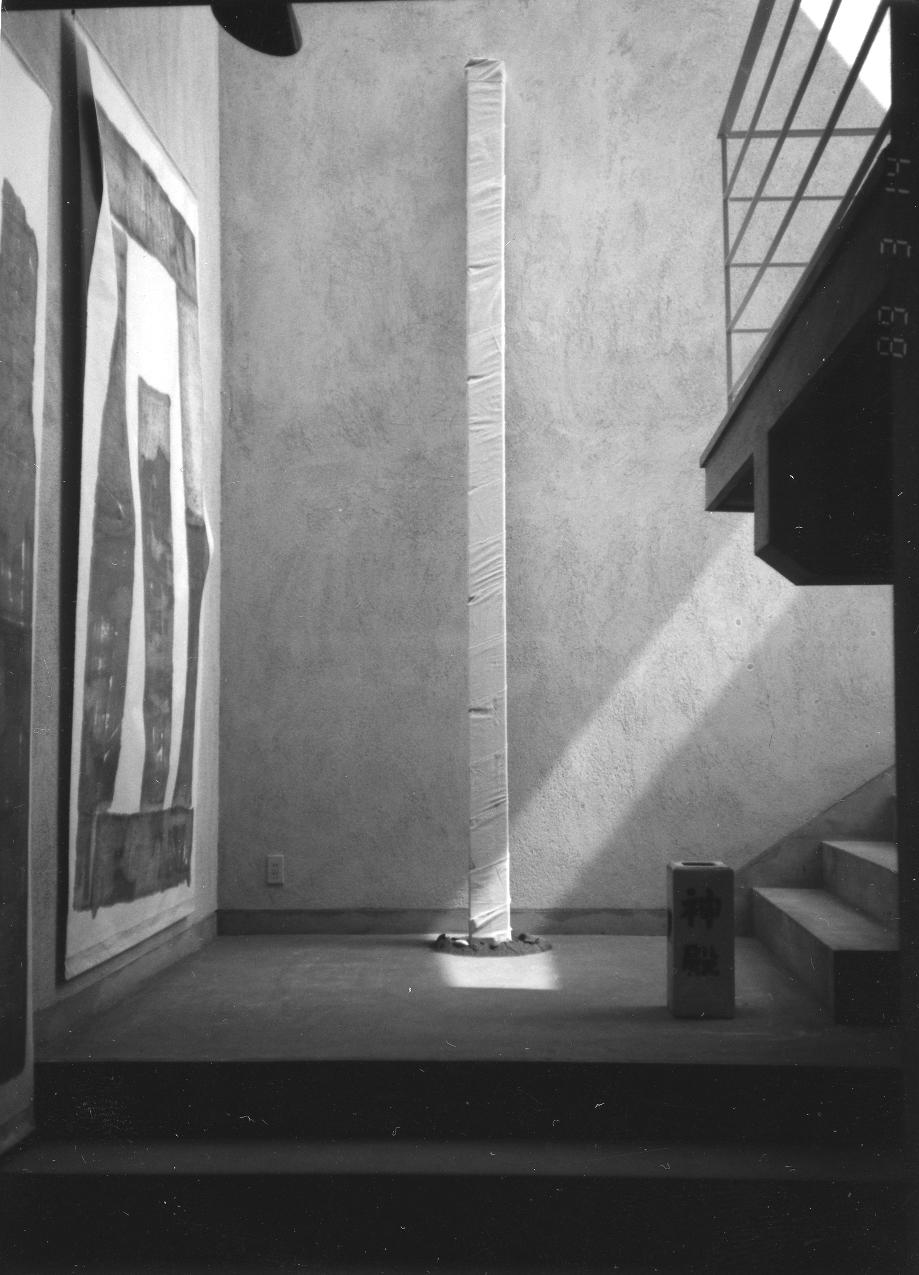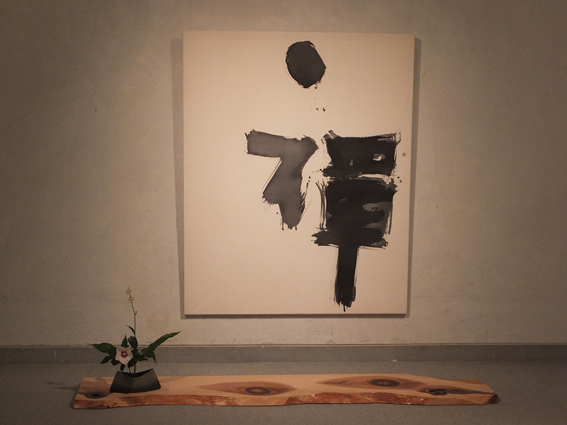
- 長岡国人2003
田鶴浜洋一郎展2013
-
解 説
平松は1975年にカイザーウィルヘルム美術館で展覧会を開催した。館長であったポール・ベンバーは無名時代のイブ・クラインを発掘し彼を紹介した著作を上梓した現代美術史家としても世界的に著名である。副館長のギセラ・フィードラーは展覧会のパンフレットに「抽象表現主義やアクションペインティングなどのように感情の充溢や内体の衝動ではなく、瞑想と物の本質への沈潜から、静思と精神の集中から始める。西洋の画家たちが東洋の思想を学んだが西洋人が東洋人になることはできない」と評価した。
平松は日本の漢字や仮名文宇を題材としていたが、それらの作品はいわゆる書道ではない。そもそも漢字は中国で生まれたが、物の形のイメージを具体的な形にしたものだ。彼女はその文宇の原点に戻り、新たに白分なりの文字を作り出す。ミニマリズムとして白、余白を追求し白地の布に墨で文字を描いた白のシリーズを制作した。
それらの絵はかつての「大和絵」が文宇と一体化していたことを想起させる。文字は既成の字体ではなくなり、絵として画面の中に自由に配置される。こうして新たな書は文字から脱却して東洋独自の抽象画になった。
神道の「清浄世界」は白を基本としながら、「わび・さび」「滅び」「幽玄」「もののあわれ」の美につながっていく。同時に禅や般若心経にみる無、空の考えは究極のミニマリズムを志向する。山水水墨画は多くの余白部分を残すことで「無」の芸術を体現すると同時に日本独自の「清浄世界」と合致した。さらに「無我」という禅の境地は、自然と人間の主客未分の一体化をめざした。無の世界、禅の世界は絵でいえば白地に墨一色の山水画、さらに抽象度を高めた枯山水という手法で表された。
枯山水で知られる龍安寺に敷き詰められた広大な白砂は海であると同時に、大自然という空間を想起させる抽象化された世界である。また、禅のわび、さびとは、個人の作為を排し、一切を自然にまかせることにより生まれる美である。Note
Hiramatsu opened the exhibition in 1975 at the Kaiser- Wi1helm-Museum. Paul Wember, the Famous director of the museum, was world-famous for the contemporary art historian who scouted the nameless Yves Klein and published his introduction and works. Gisela Fiedler, the assistant director of the museum, praised her in the exhibition's brochure that “She begins creating from the calm contemplation and spiritual concentration, meditation and deep consideration for the true nature of an object, not from the excited emotion or physical impulse such as abstract impressionism or active painting. The western artists learned the eastern philosophy, however, western people cannot become eastern people.”
She created a white series which explored minimalistic whiteness and space and created ink characters on white cloth, They echo the former Yamatoe's union of space with characters. Although Hiramatsu dealt with the Chinese and Japanese syllabary; those works cannot be described as “Calligraphy”. The Chinese character emerged in China to express an image of the form. She returned to the characters' origin and recreated her own new forms.
Then a character was no longer an established character style, but was pictorially arranged on a canvas. ln this way, a new writing freed itself from established meaning and became an original orientalistic abstract arrangement.
Shinto has an additional representative feature, its view of a “Pure world of ”Shintoism shuns impurity. A pure thing (e.g. the color white)is valued. From China Zen and other Buddhist sects arrived in Shintoist Japan where purification had been symbolized by the color white. Shintoism's White-based “pure World” leads to the beauty of “Wabi”, ”Sabi”, ”Horobi”(ruination),”Yugen”(profound Subtlety)and “Mono-no-aware”. At the Same time, the ideas of ”Mu”(void)and ”Ku”(Empty),seen in Zen and Heart Sutra, demand austere minimalism. The sumi-ink landscape painting contains many unpainted areas.
These white areas indicate the art of “Mu”(void),and this technique resonates with the unique Japanese “pure World” idea. Furthermore, Zen's idea “Muga”(selflessness)pursues nonsubjective unification between nature and human kind. The selfless Zen world view was expressed by the sumi-ink landscape painting technique which describes a stylized landscape world in black on a white background.
The Ryoan Temple is famous for this stylized landscape expressionism rendering sea against vast white sand. This mechanism helps us image the wide spread of the world. Moreover, the Wabi-Sabi of Zen is a beauty, created by leaving the natural exist while excluding individual deliberation




